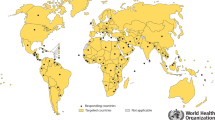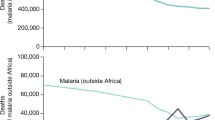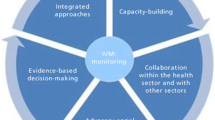Abstract
The competing public health concerns of vector-borne disease and vector control strategies, particularly pesticide use, are inherently subjective and difficult to balance. Disease response decisions must frequently be made in the absence of data or clear criteria. The factors to be weighed include the vector control measures versus those posed by the disease itself; short-term versus long-term disease management goals, specifically with regard to the issue of pesticide resistance; the need to distinguish among diseases of differing severity in making response choices; and the issue of pesticide efficacy. New York City's experience with West Nile virus has illustrated each of these issues. A framework for assessing the appropriate response to West Nile virus can serve to guide our response to likely new pathogens.
Similar content being viewed by others
References
Reigart JR, Roberts JR.Recognition and Management of Pesticide Poisonings. Washington, DC: US Environmental Protection Agency; 1999, 735-R-98-003.
Mostashari F, Poshni I, Edwin B, et al. Serosurveys for West Nile infection—New York and Connecticut counties, 2000.MMWR Morb Mortal Wkly Rep. 2001;50:37–39.
New York State Department of Health. New York State West Nile virus response plan. September 2000. Available at: http://www.health.state.ny.us/nysdoh/westnile/final.htm. Accessed: October 2, 2000.
Lenormand T, Bourguet D, Guillemaud T, Raymond M. Tracking the evolution of insecticide resistance in the mosquitoCulex pipiens.Nature. 1999;400:861–864.
Sukontason K, Olson JK, Hartberg WK, Duhrkopf RE. Organophosphate and pyrethroid susceptibilities ofCulex salinarius adults from Texas and New Jersey.J Am Mosquito Control Assoc. 1998;14:477–480.
Bisset J, Rodriguez M, Soca A, Pasteur N, Raymond M. Cross-resistance to pyrethroid and organophosphorus insecticides in the southern house mosquito (Diptera: Culicidae) from Cuba.J Med Entomol. 1997;34(2):244–246.
Wirth MC, Georghiou GP. Organophosphate resistance inCulex pipiens from Cyprus.J Am Mosquito Control Assoc. 1996;12(1):112–118.
Rawlins SC, Wan JOH. Resistance in some Caribbean populations ofAedes aegypti to several insecticides.J Am Mosquito Control Assoc. 1995;11(1):59–65.
Mekuria Y, Williams DC, Hyatt MG, Zack RE, Gwinn TA. Malathion resistance in mosquitoes from Charleston and Georgetown counties of coastal South Carolina.J Am Mosquito Control Assoc. 1994;10(1):56–63.
Gubler DJ. Resurgent vector-borne diseases as a global health problem.Emerg Infect Dis. 1998;4:442–450.
Deibel R, Srihongse S, Woodall JP. Arboviruses in New York State.Am J Trop Med Hyg. 1979;28:577–582. See also Centers for Disease Control Web site, available at: www.cdc.govncidod/dvbid/arbor/arbocase.htm.
Cernescu C, Nedela N, Tardel G, Tsai TF. Continued transmission of West Nile virus to humans in Southeastern Romania, 1997–1998.J Infect Dis. 2000;181:710–712.
Castle T, Amador M, Rawlins S, Figueroa JP, Reiter P. Absence of impact of aerial malathion treatment onAedes aegypti during a dengue outbreak in Kingston, Jamaica.Pan Am J Public Health. 1999;5(2):100–104.
Newton EAC, Reiter P. A model of the transmission of dengue fever with an evaluation of the impact of ultra-low volume (ULV) insecticide applications on dengue epidemics.Am J Trop Med Hyg. 1992;47(6):709–720.
Perich MJ, Tidwell MA, Williams DC, et al. Comparison of ground and aerial ultra-low volume applications of malathion againstAedes aegypti in Santo Domingo, Dominican Republic.J Am Mosquito Control Assoc. 1990;6(1):1–6.
Gubler DJ.Aedes aegypti andAedes aegypti-borne disease control in the 1990s: top down or bottom up.Am J Trop Med Hyg. 1989,40(6):571–578.
Thier A.The Toxic Treadmill. Albany, NY: Environmental Advocates and the New York Public Interest Research Group; 2000.
Blondell, J. Epidemiology of pesticide poisonings in the United States, with special reference to occupational cases.Occup Med State of the Art Rev. 1997;12(2):209–221.
Shafey O, Sekereke HJ, Hughes BJ, Heber S, Hunter RG, Brooks RG. Surveillance for acute pesticide-related illness during the medfly eradication program—Florida, 1998.MMWR Morb Mortal Wkly Rep. 1999;48:1015–1027.
National Research Council.Pesticides in the Diets of Infants and Children. Washington, DC: National Academy Press; 1993.
Fan A. 1998 malathion literature review. Memorandum from Anna M. Fan, PhD, Chief, Pesticide and Environmental Toxicology Section to Richard Kreutzer, MD, Chief Environmental Health Investigations Branch, Department of Health Services, California Environmental Protection Agency; June 26, 1998.
State of California Department of Health Services.Health Risk Assessment of Aerial Application of Malathion-Bait. Berkeley, CA: State of California Dept of Health Services; 1991.
Desi I, Varga L, Farkas I. Studies on the immunosuppressive effect of organochlorine and organophosphoric insecticides in subacute experiments.J Hyg Epidemiol Microbiol Immunol. 1978;1:115–122.
Contreras HR, Bustos-Obregon E. Morphological alterations in mouse testis by a single dose of malathion.J Exp Zool. 1999;284(3):355–359.
Balasubramanian K, Vijayan AP, Ananthanarayanan P, Balasubramanian A. Effect of malathion on the testis of male albino rats.Med Sci Res. 1987;15:229–230.
Wyttenbach CR, Thompson SC. The effects of the organophosphate insecticide malathion on very young chick embryos: malformations detected by histological examination.Am J Anat. 1985;174:187–202.
Rupa DS, Reddy PP, Sreemannarayana K, Reddi OS. Frequency of sister-chromatid exchange in peripheral lymphocytes of male pesticide applicators.Environ Mol Mutagen. 1991;18:136–138.
New Jersey Department of Health and Senior Services.Hazardous Substances Fact Sheet: Malathion. Trenton, NJ: New Jersey Dept of Health and Senior Services; 1997.
Thomas DC, Petitti DB, Goldhaber M, Swan SH, Rappaport EB, Hertz-Picciotto I. Reproductive outcomes in relation to malathion spraying in the San Francisco Bay area, 1981–1982.Epidemiology. 1992;3:32–39.
Johnson K. Scientist differs with EPA on malathion.New York Times. August 18, 2000: B3.
Extension Toxicology Network.Pesticide Information Profile: Malathion. Corvallis: Oregon State University; 1996.
Reigart JR, Roberts JR:Recognition and Management of Pesticide Poisonings. Washington, DC: US Environmental Protection Agency; 1999. EPA 735-R-98-003.
O'Malley M. Clinical evaluation of pesticide exposure and poisonings.Lancet. 1997; 349:1161–1166.
Muller-Mohnssen H. Chronic sequelae and irreversible injuries following acute pyrethroid intoxication.Toxicol Lett. 1999;197:161–175.
Diel F, Horr B, Borck H, Savtchenko H, Mitsche T, Diel E. Pyrethroids and piperonylbutoxide affect human T-lymphocytes in vitro.Toxicol Lett. 1999;107:65–74.
Stiller-Winkler R, Hadnagy W, Leng G, Straube E, Idel H. Immunological parameters in humans exposed to pesticides in the agricultural environment.Toxicol Lett. 1999; 107:219–224.
Go V, Garey J, Wolff MS, Pogo BG. Estrogenic potential of certain pyrethroid compounds in the MCF-7 human breast carcinoma cell line.Environ Health Perspect. 1999; 107(3):173–177.
Eil C, Nisula BC. The binding properties of pyrethroids to human skin fibroblast androgen receptors and to sex hormone binding globulin.J Steroid Biochem. 1990;35:409–414.
Extension Toxicology Network.Pesticide Information Profile: Resmethrin. Corvallis: Oregon State University; 1996.
Kegley S, Neumeister L, Martin T.Disturbing the Balance: Ecological Impacts of Pesticides in California. San Francisco: Californians for Pesticide Reform; 1999.
Bohan P, Goldman L, Treser C. American Public Health Association. Maximizing public health protection with integrated vector control.American Journal of Public Health. 2000;91:22–23. Available at: www.apha.org/legislative/policy/index/htm. Accessed: March 29, 2001.
References
Gubler DJ. Resurgent vector-borne diseases as a global health problem.Emerg Infect Dis. 1998;4:442–450.
Centers for Disease Control and Prevention.Preventing Emerging Infectious Diseases: a Strategy for the 21st Century. Atlanta, GA: US Dept of Health and Human Services, Public Health Service, Centers for Disease Control and Prevention; 1998.
Centers for Disease Control and Prevention.Epidemic/Epizootic West Nile Virus in the United States: Guidelines for Surveillance Prevention, and Control. Fort Collins, CO: US Dept of Health and Human Services, Public Health Service, Centers for Disease Control and Prevention; 2000.
Schmaljohn C, Hjelle B. Hantavirus: a global disease problem.Emerg Infect Dis. 1997; 3:95–104.
Institute of Medicine.The Future of Public Health. Washington, DC: Institute of Medicine; 1988.
US Dept of Agriculture.Pest Management Practices: 1998 Summary. Washington, DC: US Dept of Agriculture; 1999.
IPM Associates, Inc.Introduction to Integrated Pest Management for Urban Landscapes. Eugene, OR: IPM Associates, Inc.; 1996.
Food Quality Protection Act of 1996, Pub L 104-170, 110 Stat 1489 (August 3, 1996).
Brogdon WG, McAllister JC. Insecticide resistance and vector control.Emerg Infect Dis. 1998;4:605–613.
Gratz NG, Jany WC. What role for insecticides in vector control programs?Am J Trop Med Hyg. 1194;50:11–20.
United Nations Environmental Program, Persistent Organic Pollutants Committee.Report of the Inter-governmental Negotiating Committee for an International Legally Binding Instrument for Implementing International Action on Certain Persistent Organic Pollutants on the Work of Its Third Session. September 6–11, 1999. Geneva, Switzerland: United Nations; 1999.
Author information
Authors and Affiliations
Corresponding author
Rights and permissions
About this article
Cite this article
Thier, A. Balancing the risks: Vector control and pesticide use in response to emerging illness. J Urban Health 78, 372–381 (2001). https://doi.org/10.1093/jurban/78.2.372
Issue Date:
DOI: https://doi.org/10.1093/jurban/78.2.372




